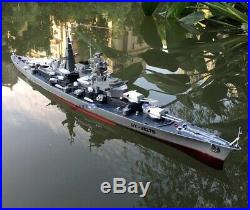
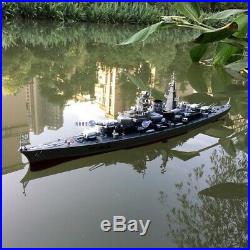
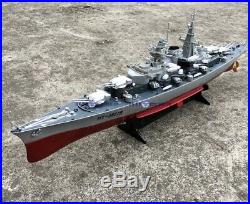
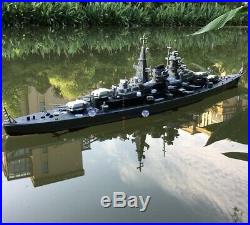

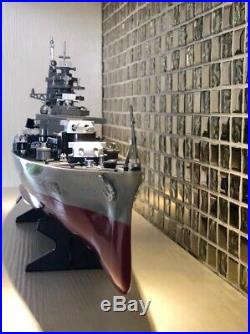
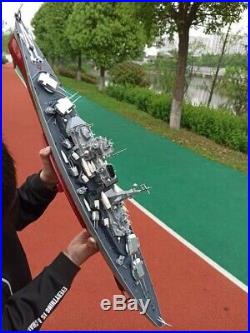

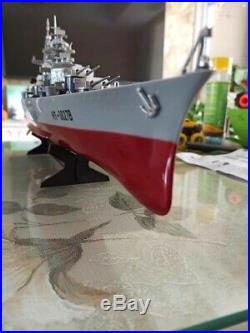

Fully Functional 2 Channel (Forward/Backward, Left/Right). Fun for All Ages. Great for calm lakes, swimming pools, and ponds. Radar Tower that lights up. Replica helicopters and jets located on Battleship. Scale Replica of Aircraft Carrier Battleship. Power System: 7.2V 800mah NiMh Battery. Radio System: 2 Channel Transmitter. Charge Time: 5-6 hours. Max Speed: 5-7 mph. HT3827B Aircraft Carrier RC KMS Bismarck battleship. 2 Channel Radio Transmitter. Rechargeable 7.2v Battery Pack. The KMS Bismarck is undoubtedly one of the most famous sea-going vessels of the 20th Century. The Germany super battleship was single-handedly responsible for tying a good portion of the British Royal Navy who dedicated themselves and their available resources to the hunting down and sinking of Hitler’s most powerful symbol of supremacy. Packed with an astounding array of guns and armored to the core, the Bismarck took a good licking before succumbing to her damages in 1941. The design was in some ways a throw-back to the designs of the First World War and were highly based on the “pocket battleship” design lessons taken from that conflict. The KMS Bismarck – a product of Blohm & Voss in Hamburg, Germany – was a giant leap forward in the rebuilding of the Germany Navy following the tight restrictions set forth on military build up following the First World War (of which Germany was the loser). Though strangely in tune with the preceding war’s design methodology, no expense was spared in making this class a truly potent force on the high seas. Of particular note were her massive batteries of 15 guns of which eight were positioned in four heavily armored turrets – two guns to a turret. Two turret emplacements were positioned forward while the remaining two were held aft. Assisting the main guns were a collection of 12 x 5.9 cannons positioned around the midship superstructure, three turrets per side with two guns each. The guns were aptly named Anton, Bruno, Caesar and Dora from front to rear. 105mm and 37mm cannons complimented the main gun array and anti-aircraft defense was augmented by a plethora of 20mm quadruple and single-mounted cannons. The midship section was of a wide berth area containing the superstructure, masts, communications equipment, life boats and a two-way catapult. Armor was the key to the Bismarck’s survival. Such attention was dedicated to the component that nearly half of the vessels overall weight constituted protection of the vital areas from shelling, bombing and torpedo hits. Vast amounts of armor were devoted to the belt and decks along with the hull and the aforementioned turret assemblies. The armor was a step behind her contemporaries serving in the American and British navies but was formidable by sheer thickness. The Bismarck had a listed top speed of 31 knots from its three massive shafts which spun three-blade propellers. The turbines were fed by no fewer than 12 x Wagner brand high-pressure steam-heated boilers which were set amidships for maximum protection and were fitted into six watertight compartments as an added measure. The Bismarck was unleashed onto the Atlantic after a lengthy eight month training period in the Baltic. On May 23, 1941, British ships attempted to intercept the mighty Bismarck and the heavy cruiser KMS Prinz Eugen on their way to Bergen. The two Royal Navy vessels, the HMS Prince of Wales and the HMS Hood were quick to respond though the German guns closed in quicker. As a result, the Hood suffered a catastrophic fire leading to an explosion thanks to the shells landed on her by the Prinz Eugen. The Prince of Wales suffers a direct hit to her bridge from the guns of the Bismarck. With the odds in Germany’s favor, the British vessels were called off. Seeing very little standing in their way, the Bismarck proceeded to enter the Atlantic playground until it was noticed that her lower structure took a hit and the system was leaking fuel. In an attempt to rectify the problem before the damage got out of hand, the captain of the Bismarck changed course for Brest and the fate of the Bismarck was sealed. Despite eluding contact with British forces, several attacks were launched against the Bismarck when it was spotted, though these would lead to very little in the way of damage, allowing the Bismarck to live another day. Day in and day out, the Bismarck swam the waters towards safety until a transmission from her was intercepted by British forces, in effect allowing enemy forces to circle in on her position. The crippled vessel continued on despite the damage though her speed was severely limited and she couldn’t turn whatsoever. Hitler’s pride of the seas had finally been put in her place. Research has backed this theory up to the extent that very little critical damage appears under the waterline of the vessel from torpedo damage though heavy damage to the superstructure is apparent. These findings would indicate that the Bismarck was in fact sunk by her owners than on any direct action of the Royal Navy – though one can imaging the ferocity of the shelling involved on their part. In any case, one can suppose the torpedo sinking of the greatest German battleship still remains a romantic scene than giving the Germans the last laugh. The KMS Bismarck was crewed by nearly 2,200 personnel consisting of over 100 officers. The vessel was ordered in 1935, laid down in 1936, launched in 1939 and officially commissioned in 1940. Today, the Bismarck rests some 15,700 feet below the ocean’s surface off the coast of Brest, France. The wreckage was discovered by Dr. Robert Ballard of Titanic fame in 1989. The battleship was the focus of the Hollywood motion picture Sink the Bismarck! The item “RC Remote Control Aircraft Carrier Battleship model KMS Bismarck battleship” is in sale since Wednesday, July 22, 2020. This item is in the category “Toys & Hobbies\Radio Control & Control Line\RC Model Vehicles & Kits\Boats & Watercraft”. The seller is “fuyanbo” and is located in Shanghai. This item can be shipped worldwide.
- Lot (Y/N): No
- Country/Region of Manufacture: China
- Vintage (Y/N): No
- Model Grade: Hobby Grade
- Material: Plastic
- Scale: 1:325
- Type: Navy/Marine
- Color: Multi-Color
- Required Assembly: Ready to Go/RTR/RTF (All included)
- MPN: HT3827B
- Age Level: 3-4 Years
- Fuel Type: Electric
- Brand: HT
- Replica of: WASP
